Comprehension – Process or Product
Listen to Nancy Hennessy author of ‘The Comprehension Blueprint’ shares insights into the elements of comprehension and how educators can facilitate comprehension for students through Structured Literacy instruction
The Subskills of Language Comprehension
Vocabulary
Below average vocabulary knowledge is a common characteristic of students with reading comprehension difficulties and specific reading comprehension deficits. ( )
Vocabulary knowledge is a key contributor to reading comprehension and the construction of a mental model of text. As the reader extracts and constructs meaning from text, they map meaning onto the printed words and decipher their relationship within the context of the sentence (Hennessey 2021). A prerequisite of understanding a text is to understand the meaning of most words. Nagy & Scott (2000) reported that proficient reading comprehension requires the reader already knowing approximately 90% to 95% of the words.
Whilst the skilled reader can unlock meaning of unknown words using context or morphology and has access to other strategies to decipher word meaning, it is critical that they have knowledge of the majority of the words, to understand a paragraph.
The relationship between vocabulary and reading comprehension is often described as reciprocal.
In the Early years, oral language development is foundational for reading comprehension. As students’ progress through school, reading itself, eventually becomes the primary contributor to ongoing growth of word meaning and knowledge (Hennessey 2021).
Principles of Effective Vocabulary Instruction
- Teach vocabulary directly and sequentially (within a knowledge rich curriculum).
- Activating prior knowledge and interest.
- Build knowledge and levels of understanding.
- Exposure students to vocabulary from a wide range of reading within various genres,
- Provide multiple exposures to the new word.
- Correct pronunciation of the word.
- Break the word into sound units (onset-rime, syllables, phonemes.)
- Identify key morphemes, root words and etymological links.
- Create semantic maps and model the use of a variety of graphic organisers.
- Provide opportunities for deep processing and retrieval practice.
(Jitendra, Edwards, Sacks & Jacobsen, 2004, Taylor, Mraz, Nichols, Rickelman & Wood, 2009)
Recommended viewing – An Introduction to Vocabulary Instruction Part 1 and 2
Part 1 The ‘What’ and the ‘Why’ of Vocabulary Instruction (Professor Pam Snow)
Part 2: How to teach Vocabulary for Reading Comprehension – (Emina McLean)
Links to further information
The Literacy Hub Morphology instruction and SSP: Q&A
Ochre resources | Australian Education Research Organisation
Vocabulary breadth and depth – Five from Five
Teaching vocabulary – Five from Five
Semantic Mapping to Grow Vocabulary – Keys to Literacy
# For a deeper understanding of Vocabulary Instruction refer to Module 4
Background Knowledge
What is knowledge?
“Knowledge is the very medium of understanding (Adams, 2015 p.5)
What Prior Knowledge & Background Knowledge?
“Prior Knowledge about the topic at hand is like mental Velcro. The relevant knowledge gives the words of the text places to stick and make sense, thereby supporting comprehension and propelling the reading process forward.” (Adams 2015, p.8)
All learning involves transfer from previous experience and prior knowledge (Willingham, 2006).
Willingham, a cognitive scientist, described how knowledge helps a learner acquire new knowledge through inference making, retrieving new information by linking it to a network of information already in their memory (schema), and solve problems from the expert’s perspective.
Prior Knowledge is described as the knowledge or skills students bring to the learning experience. Due to their varied life experiences and opportunities, prior knowledge is different for each learner. Students will all start at different stages depending upon their prior knowledge. Prior knowledge is the students personal building blocks that they use as a foundation for future learning and is essential for purposefully developing a breadth and depth of background knowledge.
Background Knowledge
Background knowledge is specific to the learning situation, problems and concepts that are presented in the texts chosen for instruction.
Whilst prior knowledge is collected over time through a variety of experiences, purposeful and incidental, background knowledge can be influenced by teachers through carefully selecting the relevant knowledge for specific texts i.e. concepts, experiences, key information, vocabulary, text structures. Teachers can then design instruction that will activate and build the knowledge required for understanding the text.
So, in summary, background Knowledge, is necessary to build a well organised representation and a mental model of a text. Effective instruction includes strategies and activities that activate, build and connect background knowledge related to the text (Hennesey, 2021).
Anderson and Freebody (1981), referred to background knowledge as the link between vocabulary and comprehension.
Listen to Natalie Wexler author of The Knowledge Gap, and Beyond the Science of Reading, talk about knowledge and reading comprehension. ( Natalie Wexler, ResearchED, Australia, March 2021)
How to build Background Knowledge
Background knowledge Strategies
- Plan read-alouds with instructional & informative texts in the primary grades including books on the same topic to build knowledge networks.
Duke (2013) advises that half of all primary read-alouds should be informational texts. Read-alouds spark curiosity and desire to learn, they help students identify with people different to themselves. The use of informational texts can also compliment fictional texts in the primary years. (Duke, 2004; Snow, Burns, & Griffin, 1998).
- View videos, documentaries on a topic to build knowledge networks
- Directly teach science, social studies, health and key vocabulary.
- Read informative text passages in intervention lessons.
- Directly teach critical knowledge before passage/text reading
- Use Graphic Organisers eg KWL Chart/ Frayer Model and Semantic Maps
- Activate and Access background Knowledge via Anticipation Guides
- Review background knowledge using retrieval practice. (Duke 2013, Archer 2022)
Graphic Organisers

What knowledge should be introduced?
Even a thin slice of knowledge supports comprehension and learning. Surface level knowledge is often the prerequisite for deep learning. Teachers need to strategically plan which knowledge is critical for the task.
When planning, consider which facts and knowledge are:
- Critical content,
- Useful for immediate comprehension,
- Useful in the future,
- Meaningfully connected to prior knowledge.
Before reading a passage
- Decide what is critical?
- What information would ease acquisition of knowledge?
- What information would reduce cognitive load?
Before introducing a topic
- Shared experiences Incursions, excursions, virtual fieldtrips
- Short video clips
How do students learn and retain factual knowledge?
Retrieval Practice acts as the bridge between short-term and long-term memory. It is a powerful learning strategy that guides students through the process of retrieving and storing information in memory. When information from the short-term memory is retrieved, it enters the working memory which temporarily holds the information whilst connections between new and previously learned information are made, further strengthening the connections and solidifying it in long term memory. This allows the information to be accessible when recalled upon in the future.
Spaced Retrieval Practice, is an even more effective strategy for long term memory, allowing the brain to consolidate the information and strengthen memory connections over time.
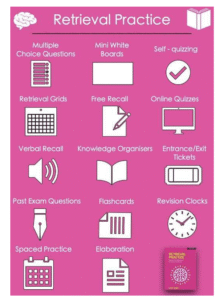
If you would like to know more about retrieval practice you can investigate the work of Anita Archer – author of the book’ Explicit Instruction’ and explore the Australian Education Research Organisations (AERO) retrieval practice videos and guides. (Links attached for your reference)
Retrieval Practice Examples for your viewing
Spacing and retrieval | Australian Education Research Organisation
AERO Tried and Tested – Spacing and retrieval practice
Spacing and retrieval practice guide | Australian Education Research Organisation
The following link also provides you with:
- A guide about how to use retrieval practice to improve learning
- A video explaining the process.
Retrieval Practice: A Powerful Strategy for Learning | Pooja K. Agarwal, Ph.D.
Free Australian Resources
Background knowledge – Five from Five
Ochre resources | Australian Education Research Organisation
Ochre Novel Studies 2025 Years 3-6 Novel Studies Update
Think Forward Educators – Read2Learn Units read2Learn — Think Forward Educators
AERO Welcome to AERO | Australian Education Research Organisation
Guides & resources | Australian Education Research Organisation
ARC – Victorian Education Department Arc: Supporting Victorian teachers | Department of Education
Making Inferences
Definition
“An inference is the identification of meaningful relations between the various parts of the text, and between those parts and the readers’ background knowledge” (Kendeon, Bohn-Gettler, White, & Van de Broek, 2008, p. 259).
This definition clearly acknowledges the connections between parts of the text e.g. words, sentences, paragraph, chapters etc., and the relationship between the text and the readers background knowledge (Hennesy, 2021).
“Texts cannot be understood without contribution from readers. Texts provide instructions to readers about how to use relevant knowledge and experience to build an understanding of the text. This building of understanding depends heavily on the reader’s ability to draw inferences’ (Ebro and Buch-Iversen 2013 p435)
A skilled readers can make inferences by connecting information from a text to:
- personal knowledge (prior knowledge/ background knowledge)
- knowledge in different parts of the text
- vocabulary knowledge
Effective instruction in inference making
When planning instruction to support inferencing making consider the following:
- Explicitly teach what an inference is and how one is made whilst reading using modeling and thinking aloud.
- Identify the critical information within the text.
- Make connections to their background knowledge, semantic network /schema
- Make connections with information that is not explicitly stated in the text.
- Make connections with information that is connected across the various parts of the text.
- Make connection using their understanding of specific textual features and language features such as, text connectives, conjunctions and, pronoun referencing etc.
- Prompt inference generation through questioning, scaffolding and feedback.
- Use graphic organizers to visually sort, store and collate information
Why teach inferencing?
Inferencing is a prerequisite for the development of higher order thinking (Marzana, 2010). Inferencing skills are necessary for students to understand texts across all strands of the curriculum.
Read and view the following for examples of how to teach inferencing. It includes a basic inference teaching model from Marzano (2010), graphic organisers and a strategy called “It says, I say, and so” created by Kylene Beers (2023). There is also a selection of lessons from K to Grade 4, ideas how to differentiate instruction, how it is used across the curriculum in maths, science and social studies, and links to further resources.
Further Resources
Making inferences – Five from Five
Grade K-2: Inferencing Strategies | Reading Rockets
Khan Academy Making Inferences
Language Structure- Syntax and Semantics
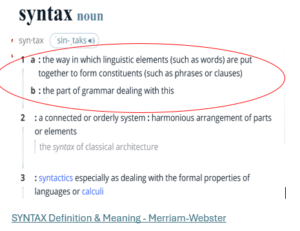
Sentence Structure – Syntax
Syntax refers to the rules and principles that govern the structure of sentences. It involves the arrangement of words into phrases and clauses to create meaningful sentences. If the positions of words are changed in a sentence, it is possible to change the meaning of the entire sentence.
For example, the following sentences contains the same words, but they have different meanings. This is due to the location of the words in each sentence and the roles that they play.

All languages have specific rules which govern the placement of words. Skilled writers manipulate the placement of words to affect the impact of their writing.
In linguistics syntax refers to:
- Word order
- Grammar rules e.g. Subject-verb agreement
For a deeper understanding view the following video – What is a sentence?
For a deeper dive into the importance of Syntax watch and listen to the amazing William Van Cleave talk about Why Syntax Matters: The Link Between Sentence Writing & Sentence Comprehending
On the anniversary of William’s passing Dr Pam Kastner shared access to her Wakelet of all of the amazing work William has generously shared. I Have attached this link for your reference. There are many videos of Williams teaching available online and his books and resources are still available to purchase. VALE William!
The William Van Cleave Collection – Wakelet (Shared generously by Dr Pam Kastner) https://wakelet.com/wake/XuIDNfx7OXoxLImeFyalj
Here is another example of another syntax resources readily available.
The following video describes 3 Types of Sentences – Declarative sentence, Interrogative Sentences, Imperative Sentences
The following video explains syntax
https://youtu.be/tZTGglxxS7A?si=9122Qxt6geQ9tneY
Links to resources and further learning
Research-Based Writing Practices and the Common Core: Meta-analysis and Meta-synthesis
Why We Need to Teach Sentence Comprehension | Reading RocketsWhat Teachers Need to Know about Sentence Comprehension | Reading Rockets
Syntax instruction (Quality Teaching Resources)
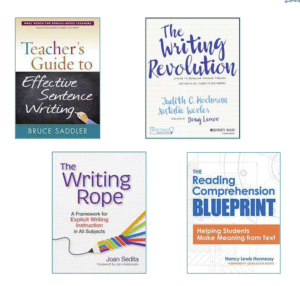
Short, targeted lessons (15 minutes) Embedded within meaningful reading and writing tasks.
When planning instruction consider the following:
- Systematic and explicit
- Make purpose, learning Intention and success criteria explicit.
- Use clear and concistant metalanguage.
- Use a functional grammar approach.
- Gradual release of responsibility – I Do, We Do, You Do.
- Call upon frequent student responses.
- Provide immediate feedback and correction.
- Cumulative and Spaced retrieval and
- Incorporate in Daily Review (see resources)

Teaching Sentence Types
- Explicitly teach the structure/ features of the sentence type
- Sorting sentences into sentence types
- Identify sentence type and add/ correct punctuation.
- Sentence generation
- Changing a sentence
- Find examples of sentence types in texts – Eye Spy!
Syntax Instruction Ochre Education
- Combine sentence fragments
- ‘Wh’ question expansion sentences – Who, What, Where/ When/ Why
- Sort sentence parts
- subject/ predicate
- independent/ dependent clauses
- phrases and clauses
- Picture prompted generation
- Sentence forms (Syntax Project & William Van Cleave, 2014)
- Sentence Elaboration & Sentence Stems
- Conjunctions – Subordinate and Co-ordinating
High-impact activities
- Sentence elaboration – sentence expanding sentence stems
- Sentence combining
Example Lessons from Colourful Semantics

Colourful Semantics: A teacher’s guide
colourful semantics – Search Videos
Simple Sentences – Nouns and Verbs
Colourful Semantics Lesson 2: People, Places and Things
https://youtu.be/cZedLi6aaM0?si=NeHKh5TFft243-YX
Syntax Concepts & Metalanguage – Word types

Semantics & Semantic Mapping
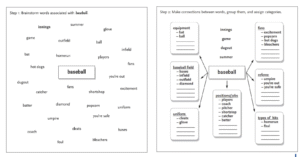
Connecting Word Meanings Through Semantic Mapping | Reading Rockets
Semantic Mapping to Grow Vocabulary – Keys to Literacy
Comprehension Instruction Archives – Keys to Literacy
#scienceofreading #reading #read #teachers #teach #writing #write… | Melissa & Lori Love Literacy™
Shape Coding
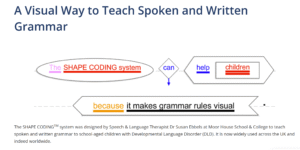
The system uses a visual coding system to show the rules for how words are put together in sentences, to develop their understanding of spoken and written grammar and to develop their ability to use grammar successfully to express themselves.
The Shape Coding system uses colours (parts of speech), arrows (tense and aspect) and shapes (syntactic and argument structure) to support school-aged children to understand and use these grammatical rules.
Links to App and Video explaining how Shape Coding can be used to support students).
SHAPE CODING™ System – A Visual Way to Teach Spoken and Written Grammar
App Info – SHAPE CODING™ System
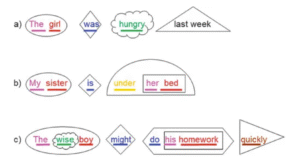
Resources
Ochre Education The Grammar Project and Daily Review resources
Morphology instruction and SSP: Q&A
Guides & resources | Australian Education Research Organisation
Language Structures
Cohesive Ties
Cohesive ties refer to the linguistic elements that link sentences and paragraphs together to create a unified or cohesive text. Writers use cohesive ties to enhance coherence, making it easier for the reader to follow the writer’s thoughts.
Cohesive ties assist the reader by guiding them through the text by linking ideas and maintaining flow.
There are different types of cohesive ties. Grammatical ties like conjunctions and lexical ties such as synonyms and antonyms.
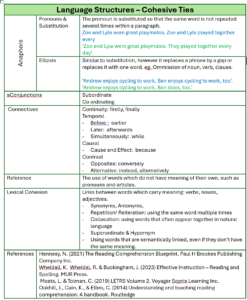
Resources for your reference
Syntax / Grammar Project (Ochre)
Aero – Victorian Education Department Curriculum and Teaching Resources
William Van Cleave Texts – Writing Matters (2012), Syntax Matters, Sentence Sense (2015), Phrases and Sentences for reading and Spelling (2013).
Anita Archer – Explicit Instruction
Links for further information and resources
What is Syntax? Definition, Rules, and Examples | Grammarly
Free Resources – Keys to Literacy
Cohesive ties – Five from Five
Sentence Combining | Reading Rockets
Grammar and Syntax Archives – Keys to Literacy
Year 1- Syntax — The Grammar Project
Year 5/6 Syntax — The Grammar Project
Literacy Knowledge – Print Concepts, Text Structure
Literacy Knowledge includes the ways in which information is organised in different types of texts e.g. example, chapter headings, subheadings, tables of contents, indexes and glossaries, overviews, introductory and concluding paragraphs, sequencing, topic sentences etc.
The combination of text structures and language features define a text type and shape its meaning. Texts are classified according to the particular purposes they are designed to achieve.
Students learn how texts are structured for different audiences and contexts, and to achieve particular purposes. They learn the techniques that authors use to guide and influence the reader or viewer through effective use of resources at the level of the whole text, paragraph and sentence.
The Australian Curriculum V9 describes as:
Texts can be written, spoken, visual, multimodal, and in print or digital/online forms. Multimodal texts combine language with other means of communication such as visual images, soundtrack or spoken words, as in film or digital media. Texts include all forms of augmentative and alternative communication; for example, gesture, signing, real objects, photographs, pictographs, pictograms and Braille. Texts provide important opportunities for learning about aspects of human experience and about aesthetic value. Many tasks that students undertake in and out of school involve understanding and producing texts in everyday and workplace contexts. The purposes of these texts may be aesthetic, imaginative, reflective, informative, persuasive, analytical and/or critical, or any combination of these.
Distinctions among types of texts can be useful when selecting materials for students at each year level to listen to, read, view, write and create. These distinctions can also guide the kinds of purposeful activities that can be organised around these materials. Although many types of texts are easy to recognise based on their subject matter, forms and structures, the distinctions between types of texts need not be sharply defined or formulaic.
Teachers and schools are best placed to make decisions about the selection of texts in their teaching and learning programs to address the content in the English curriculum while also meeting the needs of the students in their classes. (Australian Curriculum, Assessment and Reporting Authority, 2024 [ACARA] 2024).
Exposure to different text structures
When planning, consider that children require explicit instruction on gaining meaning from different types of text structure e.g. Narrative, Expository, Informative and Procedural texts etc. Consider:
- Identifying key words associated with specific text structure
- Explicitly teach text structure and textual features/ characteristics e.g. story grammar in narrative text (e.g., setting, characters, events, problem, solution, ending)
- Explicitly teach sentence types and structures, punctuation, tense, grammar
- Use graphic organizers to identify key information
- Plan opportunities for questioning and retrieval practice.
Listen to the following video about how to teach text structures across all subject areas.
Instructional consideration for building knowledge of Text Structure
5 Step Process (K-2)
- Teach / review text structural elements
- Activate Prior Knowledge
- Read text and identify macro elements
- Answer questions & recall macro elements
- Orally retell
Wordless videos
Use wordless videos are a great resource for creating story retell frames and motivating learner.
Animated Videos – suitable for narrative and sentence writing stimulus
Ormie the Pig https://youtu.be/EUm-vAOmV1o?si=2QZNtJ_4mGmAoy-P
Simon’s Cat https://youtu.be/v6c76z6oQmw?si=Rf_WCy-Hw06y6_Tp
Other Instructional Ideas
Annotating text
Note: When annotating a text, it is advised that the Year level teaching cohorts have annotated an ‘A level’ exemplar for reference and consistency across the year.
Annotate text to identify macro features- Years 3-7
Annotated Text Poster%E2%80%94Annotating a Text.pdf
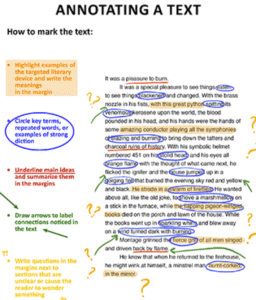
Retell Prompts and Frames:
![]()
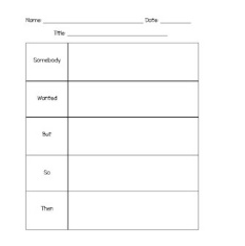
Column Notes
Summarising
- Scaffolds to Support Summarizing – Keys to Literacy
- Summarizing | Reading Rockets
- The Art and Science of Teaching / Summarizing to Comprehend
Summarising the main idea
- Preview the text (Informative Text)
- ID text features / Ask what the main idea is based on the features
- Identify Key Words (highlight or annotate)
- Differentiate between Main Idea and details
- Use graphic organisers to organise and record
Summarise Individual Paragraphs/ Videos
(Links to Anita Archer’s work Explicit Instruction attached for your reference).
- indb
- https://youtu.be/N5dxpyNCT80?si=KhOtZzqwc6PVa6ve
- Explicit Instructions | Effective and Efficient Teaching » 6. Summary Writing Using a Frame – 1st
- Explicit Instructions | Effective and Efficient Teaching » Video – Elementary
- Explicit Instructions | Effective and Efficient Teaching » Video – Secondary
- Explicit Instructions | Effective and Efficient Teaching » 3. Vocabulary Instruction – Sixth Grade Language Arts
Note: There are many readily available teaching resources however select carefully and ensure that they are research and evidence supported.
Reading Rockets, Five from Five, The Khan Academy, Pattan, UFLI Foundations Resources, SPELD, Spelfabet, 95% Group, OCHRE, ARC etc have generously collated a series of teacher resources that are freely available to all. I have attached some examples for your reference:
Links to some of these are attached below.
- Toolbox-AUS | U F Literacy Institute
- Effective, evidence-based reading resources – Five from Five
- Understanding Text Types | Reading Rockets
- Teaching Text Structure | Reading Rockets
- Implementing the Text Structure Strategy in Your Classroom | Reading Rockets
- Text structure – Five from Five
- PaTTAN Literacy Resource Hub
- Professional Learning Video Modules (Good Great School)
- com.au
- Evidence-Based Literacy Solutions | 95 Percent Group
Text Features
- Interpreting text features | Reading | Khan Academy https://youtu.be/Zx2A9WAswCo
- Teaching Text Features | Reading Rockets
Reading Purpose and Standard for coherence
Reading purpose and standard for coherence – Five from Five
